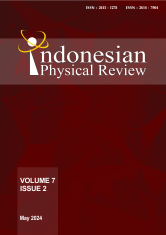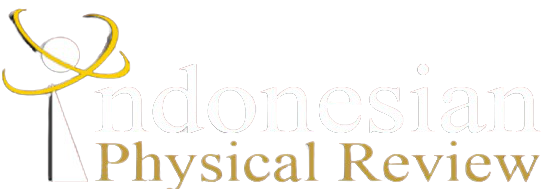SYNTHESIS AND CHARACTERIZATION OF ACTIVATED CARBON PREPARED FROM RICE HUSK BY PHYSICS-CHEMICAL ACTIVATION
DOI:
10.29303/ipr.v7i2.311Downloads
Abstract
Activated carbon is an amorphous carbon material predominantly composed of free carbon atoms with high adsorption capacity. The amorphous structure in activated carbon affects its adsorption capacity; the higher the percentage of amorphous carbon, the greater the adsorption capacity of the activated carbon. Activated carbon can be obtained from rice husk waste containing 30-40% C in cellulose, hemicellulose, and lignin. Therefore, this study was conducted to observe activated carbon's phases, morphology, elemental composition, and particle size. Activated carbon was synthesized using a physics-chemical activation method, which began with washing the rice husk samples, followed by air drying, carbonizing into charcoal, and grinding it finely. The rice husk charcoal powder was then physically activated at a temperature of 500℃. The physically activated product was then chemically activated using 6M HCl with a charcoal-to-activator ratio of 1:10 (m/V), stirred at 250 rpm for 1 hour, and then allowed to settle for 24 hours. It was then washed and dried to produce activated carbon powder. XRD test results showed diffraction peaks at 2θ = 22.23° without sharp or pointed peaks, indicating that the activated carbon has an amorphous structure. SEM test results showed the morphology of rice husk-activated carbon with spherical particle shapes and a particle size distribution of 20-70 nm. EDX test results showed that the rice husk activated carbon is predominantly composed of C, O, and Si with respective percentages of 54.31%, 40.04%, and 2.49%.Â
Keywords:
Shynthesis Characterization Activated Carbon Rice HuskReferences
D. E. G. Sofhia, W. Nurhasanah, and J. M. Munandar, " Pemanfaatan limbah sekam padi menjadi produk arang sekam untuk meningkatkan nilai jual di desa gunturmekar, kabupaten sumedang," Jurnal Pusat Inovasi Masyarakat, vol. 2, no. 4, p. 679-684, bulan tahun. Doid:
C. A. Riyanto, E. Kurniawa, and N. R. Aminu, “Pengaruh NaOH dan suhu aktivasi terhadap karakteristik karbon aktif sekam padi teraktivasi H3PO4,†Rafflesia Journal of Natural and Applied Sciences, vol. 1, no. 2, p. 59-68, Oktober 2021.
Ferdiansyah, A. S. A. Premesti, A. R. Fathichin, B. M. G. Ariani, A. H. Fahmim and Y. W. Mirzayanti. Review Studi: analisa pemanfaatan limbah sekam padi sebagai bahan material maju. Prosiding Seminar Nasional Teknologi Industri Berkelanjutan III, March 4, 2023.
Shofa, “Pembuatan karbon aktif berbahan baku ampus tebu dengan aktivasi kalium hidroksida†Depok, Indonesia University, July 4, 2012.
I. Listiana, R. Bursan, R. A. D. Widyastuti, A. Rahmat, and H. Jimad, â€Pemanfaatan limbah sekam padi dalam pembuatan arang sekam di pekon bulurejo kecamatan gadingrejo kabupaten pringsewu,†Jurnal Pengabdian Masyarakat, vo. 3, no. 1, p. 1-5. 2021.
Hendriyana, “Kajian awal pemanfaatan sekam padi menjadi karbon aktif,†Jurnal Teknik, vol. 10, no. 2, p. 83-89, November 2011.
I. F. Anggraini, E. Kusniawati, and M. Mayanagsari, “Pemanfaatan tongkol jagung pada pembuatan karbon aktif dengan menggunakan aktivator (Na2CO3) serta pengaruhnya terhadap sampel air sumur gali menggunakan parameter ph, turbidity, total suspended solid (TSS) & total disolved solid (TDS),†Jurnal Cakrawala Ilmiah, vol. 2, no. 5, p.2261-2271, 2023.
S. Huda, R. D. Ratnani, and L. Kurniasari, “Karakterisasi karbon aktif dari bambu ori (bambusa arundinacea) yang di aktivasi menggunakan asam klorida (HCl),†Inovasi Teknik Kimia, vol. 5, no. 1, p.22-27, April 2020.
Wardalia, “Karakterisasi pembuatan adsorben dari sekam padi sebagai pengadsorpsi logam timbal pada limbah cair,†Jurnal Integrasi Proses, vol. 6, no. 2, p.83-88, 2011.
A. Saban, Jasruddin, and Husain, “Pengaruh konsentrasi aktivator (NaOH dan HCl) terhadap karakteristik karbon aktif dari tongkol jagung menunjukkan karbon aktif tongkol jangung,†Junal Sains dan Pendidikan Fisika (JSPF), vol. 19, no. 2, p. 219-228. August 2023. Avaliable: http://ojs.unm.ac.id/jsdpf.
R. Dwityaningsih, T. E. P. S. Rahayu, M. Handayani, and M. Nurhilal, “Pengaruh variasi konsentrasi H3PO4 sebagai zat aktivator terhadap karakteristik karbon aktif dari sekam padi,†Infotekmesin, vol. 14, no. 1, p. 98-104, January 2023. DOI: 10.35970/infotekmesin.v14i1.1641.
L. I. Wirani, “Aktivasi karbon dari sekam padi dengan activator asam klorida (HCl) dan pengaplikasiannya pada limbah pengolahan baterai mobil untuk mengurangi kadar timbal (Pb),†Medan, North Sumatera University, January 26, 2017.
J. B. Njewa, E. Vunain, and T. Biswick, “Synthesis and characterization of activated carbons prepared from agro-wases by chemical activation,†Journal of Chemistry, p.1-13 March, 2022. Avaliable : https://doi.org/10.1155/2022/9975444.
E. H. Sujiono, D. Zabrian, Zurnansyah, Mulyati, V. Zharvan, Samnur, and N. A. Humairah, “Fabrication and characterization of coconut shell activated carbon using variation chemical activation for wastewater treatment application,â€Result in Chemistryâ€, p. 1-10, January 2022. Available: https://doi.org/10.1016/j.rechem.2022.100291.
A. H. Wazir, I. U. Wazir, and A. M. Wazir,â€Preparation and characterization of rice husk based physical activated carbon,â€Energy Sources, Part A: Recovery, Utilization, And Environmental Effects, p.1-12. DOI: 10.1080/15567036.2020.1715512.
C. Bijang, M. F. J. D. P. Tanasale, D. Sri, Tahril, L. A. Kadir, and T. Azis, “Synthesis and characterization of activated carbon from waste compedak fruit (artocarpus champeden) activated h3po4 as adsorbent of methylene blue,†Jurnal Akademika Kimia, vol. 11, no. 1, p. 56-63, February 2022. DOI: 10.22487/j24775185.2022.v11.i1.56-63.
F. P. Perdani, C. A. Riyanto, and Y.Martono, “Karakterisasi karbon aktif kulit singkong (manihot esculenta crantz) berdasarkan variasi konsentrasi h3po4 dan lama waktu aktivasi,†Indonesian Journal of Chemical Analysis, vol. 4, no. 2, p. 72-81, September 2021. DOI: 10.20885/ijca.vol4.iss2.art4.
M. N. Islam, J. Sraker, A. Khatton, S. M. M. Hossain, H. A. Sikder, R. Ahmed, and A. M. S. Chowdhury, “Synthesis and characterization of activated carbon prepared from jute stick charcoal for industrial uses,†Scholars International Journal of Chemistry and Material Sciences, vol. 5, no. 3, p. 33-39, March 2022. DOI: 10.36348/sijcms.2022.v05i03.003.
C. A. Riyanto, E. Prabalaras, and Y. Martono, “Karakterisasi nanopartikel karbon aktif dari daun eceng gondok (eichhornia crassipes) berdasarkan variasi suhu dan waktu aktivasi,†Jurnal Kimia dan Kemasan, vol. 42, no. 2, p. 85-92, September 2020. DOI: 10.24817/jkk.v42i2.5633.
R. Y. Nurcahyo, and P. J. Wibawa, “Fabrikasi ramah lingkungan komposit nano karbon aktif-partikel perak dan uji aktifitas antibakterinya,†Greensphere: Journal of Environmental Chemistry, vol. 2, no. 1, p. 31-37, May 2022. DOI:10.14710/gjec.2022.14827
L. Yu, I. D. Tatsu, and T. Kondo, “Preparation of carbon nanoparticles from activated carbon by aqueous counter collision,†Journal of Wood Science, vol. 68, no. 29, p. 1-8, May 2022. Avaliable: https://doi.org/10.1186/s10086-022-02036-3.
N. Masta,†Buku materi pembelajaran scanning electron microscopyâ€, Jakarta: Universitas Kristen Indonesia, 2020.
A. I. Bakti, M. M. Lemembang, and Jumriadi,†Karakterisasi karbon aktif yang terbuat dari tempurung kelapa menggunakan Teknik pirolisis dengan aktivasi fisika dan kimia,â€Jurnal MIPA, vol.12, no.2, p.56-60, August 2023. DOI: https://doi.org/10.35799/jm.v12i2.46160.
A. Kwaghger, and J. S. Ibrahim,â€Optimization of conditions for the preparation of activated carbon from mango nuts using HCl,†American Journal of Engineering Research, vol. 2, no. 7, p. 74-85, 2013.
R. Garg, A. Gaur, and R. P. Chauhan,†Synthesis and characterization of rice husk activated carbon by torrefaction, desilication, and alkalies based approach,†Indian Journal of Engineering & Materials Sciences, vol. 30, p. 567-572, August 2023. DOI: 10.56042/ijems.v30i4.3744.
Z. Sitorus, Halimatuddahliana, E. Sembiring, and R. F. Y. Butar-butar,†Synthesis of activated carbon from rice husk as a filter for iron (Fe) and copper (Cu) in well water,†International Conference on Physics and Applied Physics, 2733 012007, 2024. DOI:10.1088/1742-6596/2733/1/012007.
License

This work is licensed under a Creative Commons Attribution-NonCommercial-ShareAlike 4.0 International License.
Authors who publish with Indonesian Physical Review Journal, agree to the following terms:
- Authors retain copyright and grant the journal right of first publication with the work simultaneously licensed under a Creative Commons Attribution-ShareAlike 4.0 International Licence (CC BY SA-4.0). This license allows authors to use all articles, data sets, graphics, and appendices in data mining applications, search engines, web sites, blogs, and other platforms by providing an appropriate reference. The journal allows the author(s) to hold the copyright without restrictions and will retain publishing rights without restrictions.
- Authors are able to enter into separate, additional contractual arrangements for the non-exclusive distribution of the journal's published version of the work (e.g., post it to an institutional repository or publish it in a book), with an acknowledgment of its initial publication in Indonesian Physical Review Journal.
- Authors are permitted and encouraged to post their work online (e.g., in institutional repositories or on their website) prior to and during the submission process, as it can lead to productive exchanges, as well as earlier and greater citation of published work (See The Effect of Open Access).





